Arab Horses
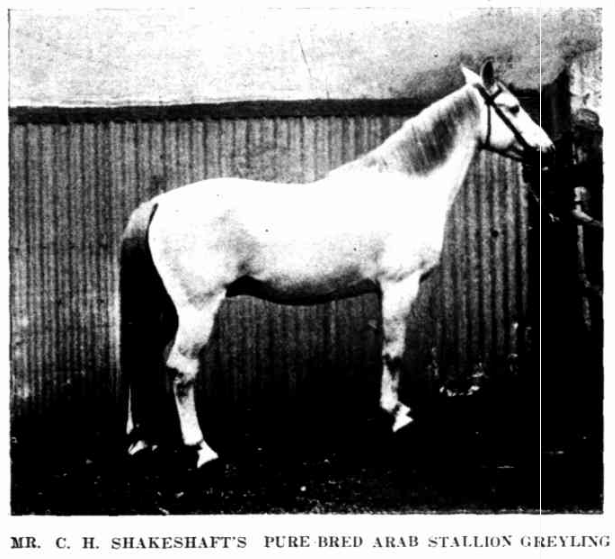
Background Breeds
Janet Lane on Waler Data Base @ Facebook. Image: Kapunda Herald, S.A., 7th September 1906.
Arab horses (now Arabian – using terms of the day for historical context; ‘Arabian’ was used very rarely). Continuing the background of the Waler…
When Australia was colonised Britain held most of India. Many settlers came straight here from India – such as Mr. Princep who took up grants in Van Dieman’s Land and Western Australia and sent out shiploads of Arab horses from Calcutta in the 1840’s – his aim to breed horses for the vast armies in India. Many others had the same idea.
It was a shorter and safer trip than the arduous journey from England, for horses. Arabs were by far the most coveted and popular horse with the British armies at the time. This breed was the Waler’s main rival for sales in India.
For centuries there’d been a trade from Persia (Iran), Syria, Turkey and Arabia (Iraq) to India for horses – Indian empires such as the Mughals being excellent customers for military horses – many going down the Euphrates River, some overland, to the port of Bussorah (now Basra) – the horse trade was enormous. Breeders were extremely reluctant to sell mares – it was invariably stallions that went to India to the giant horse bazaars.
Image: Sydney Stock and Station Journal, Tuesday 26 September 1916. This article has an alphabetical list of many of the Arabs that went into Volume 1 of the Australian Thoroughbred Studbook (ASB).

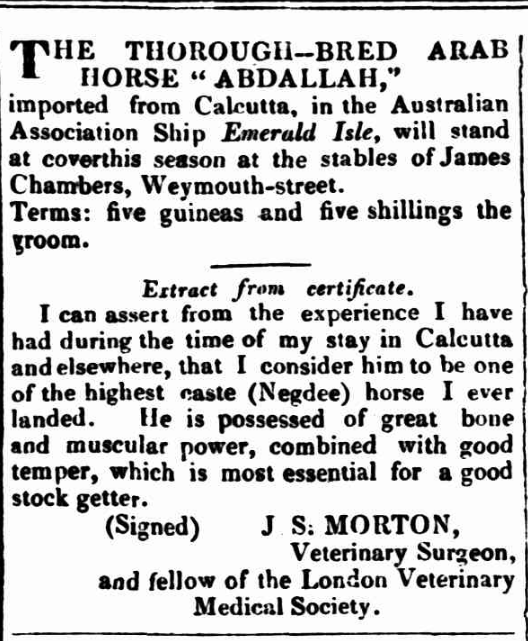
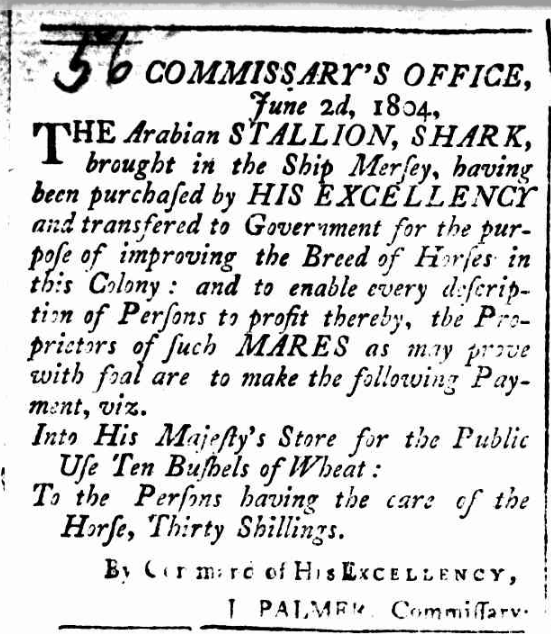
Images: Southern Australian, Adelaide, Thursday 30 January 1840; Sydney Gazette and New South Wales Advertiser, Sunday 3 June 1804.
These are just a few examples; from earliest colonisation papers were full of ads in the stud season, and Arab stallions always featured, among the many other breeds and the colonial horses.
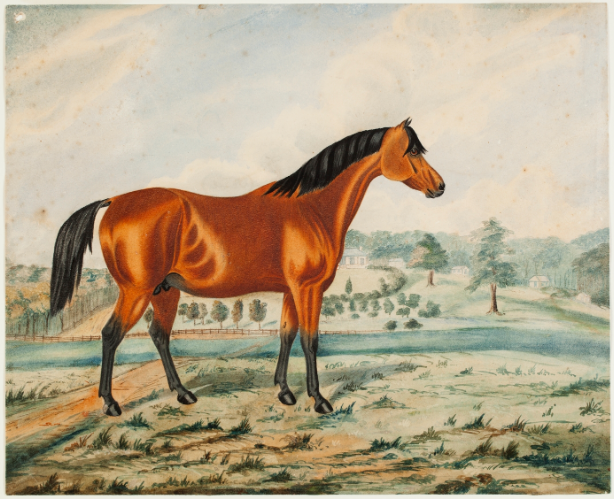
St Heliers by an Arab (Satellite) out of an imported mare, [183-], State Library NSW
Henry Dumaresq (1792-1838) arrived in Sydney in 1825 as advance agent for Governor Ralph Darling. Soon after his arrival he showed an interest in horse racing and had success on the track with Alraschid (Arab) and the fillies Modus and Currency Lass by Stride (Imp). In 1831 Dumaresq retired to St Helier’s, his Hunter Valley estate. The first important sire to stand at St Helier’s was the bay Satellite (Arab). This stallion was imported from Madras, arriving in the colony in 1823 on the ship Satellite. He was at St Helier’s from about 1832, and later stood at Camden Park where he died in the 1840s.
About 1833, Dumaresq bred the Anglo-Arab sire St Heliers by Satellite (Arab) out of Silvertail by Warrior. Dumaresq imported the mare Silvertail from England. St Heliers (horse) was sold to the Australian Agricultural Company.’
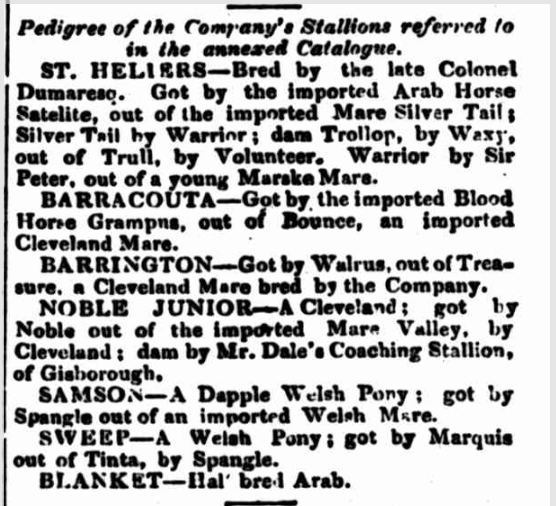
Due to empirical actions of Britain several direct markets of Arab horses became closed to them. Large bribes had to be paid in countries of origin and mares were a giant sum – often 250 pounds. Thus to the Indian bazaars the English went instead. Indians were big buyers hence the supply. Arab horses were still more expensive than Thoroughbreds. They were a tremendous status symbol.
As Australia was being settled the horse trade took off. We bred from everything that came in, not just for our own use – the export trade was profitable. It’s thought the ‘one-man horse’ bond of Walers, their affection for humans, comes from these early Arab horses, for centuries part of the family of their breeders.
Arab Pony, Snow. Sydney Mail and New South Wales Advertiser, Saturday 4 July 1896
‘Mr. Vincent Dowling, of Lue, has just imported from India, to use the words of Mr. E. D. Millar, in ‘Modern Polo,’ ‘probably the best Arab pony playing in India, Snow. He is white on a black skin, 12 years old, and 14. 1½ hands. At polo he played in many tournaments, and quite recently played in the Regimental Tournament for the championship of India, which was won by the Durham Light Infantry team, of which Captain de Lisle, his owner, was a member. He was also in the winning team of three tournaments in ’91 and ’95. At racing he has also been a champion, having won 32 races, both on the flat and over timber, from 3 furlongs to 2 miles, and won four first prizes at the Bombay Horse Show last year. The pony has been imported for stud purposes. Our picture is from a photograph taken in India, and represents him in polo rig, with Captain de Lisle on his back.’
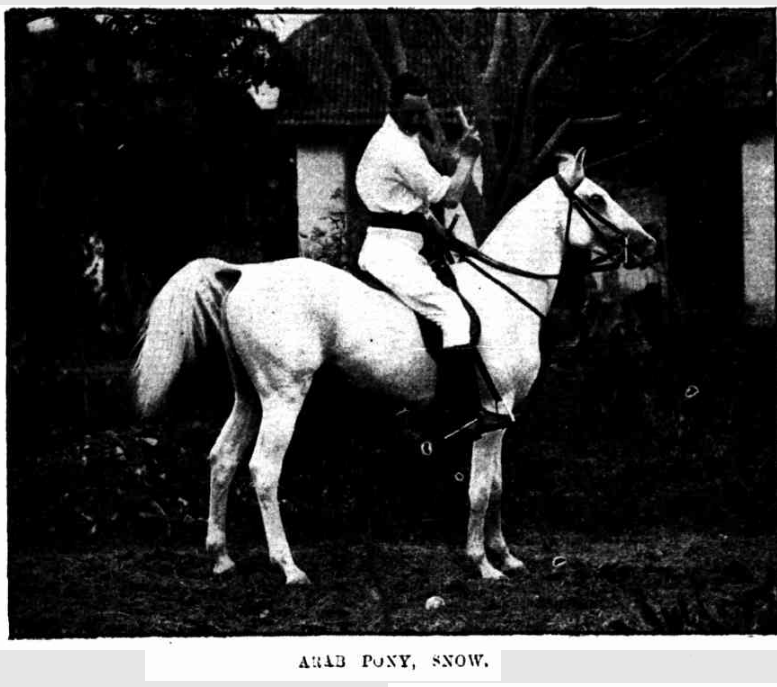
This little stallion, Snow, an Arab imported from India, also ran on Lue station near Mudgee. Another astute buy by Vincent Dowling. He cost thousands of pounds. Vincent had done the hard years, coming here in 1835 he overlanded cattle and horses all over the country. Once he went 70 hours without a drink and almost died. He was an excellent horseman. Eventually he got his own property; in fact owned several as he moved about.
Snow is typical of Arabs we imported for over a century. India in turn got them from Arabian countries (a massive horse trade for centuries). Most horse traders taking Walers to India brought back one or two Arab stallions (no mares were sold there) – Snow was brought back for that great trader Stephen Ralli, on return from taking a load over for Ralli. and sold to Dowling. Pony racing was huge here, and we sold tens of thousands of racing ponies overseas; races were in height classes.
Snow was the champion polo pony of India – and he’d won an extraordinary 32 races there – some races over two miles. He’d also won numerous show ribbons.
These Arab ponies (he’s actually galloway size) were tried and true; hardy, with stamina and tough legs and feet. Surprisingly good bone – Snow measured 7 and three quarters inches bone. 64 inches girth. He stood 14.2hh. He had black hooves and black skin. They were also noted for their very good temperament.
Vincent Dowling is typical of many breeders who bought the best he could to develop the types needed for the lucrative horse trade. He had three Norfolk stallions also on Lue, two imported, one Australian bred (a roadster type of good bone).

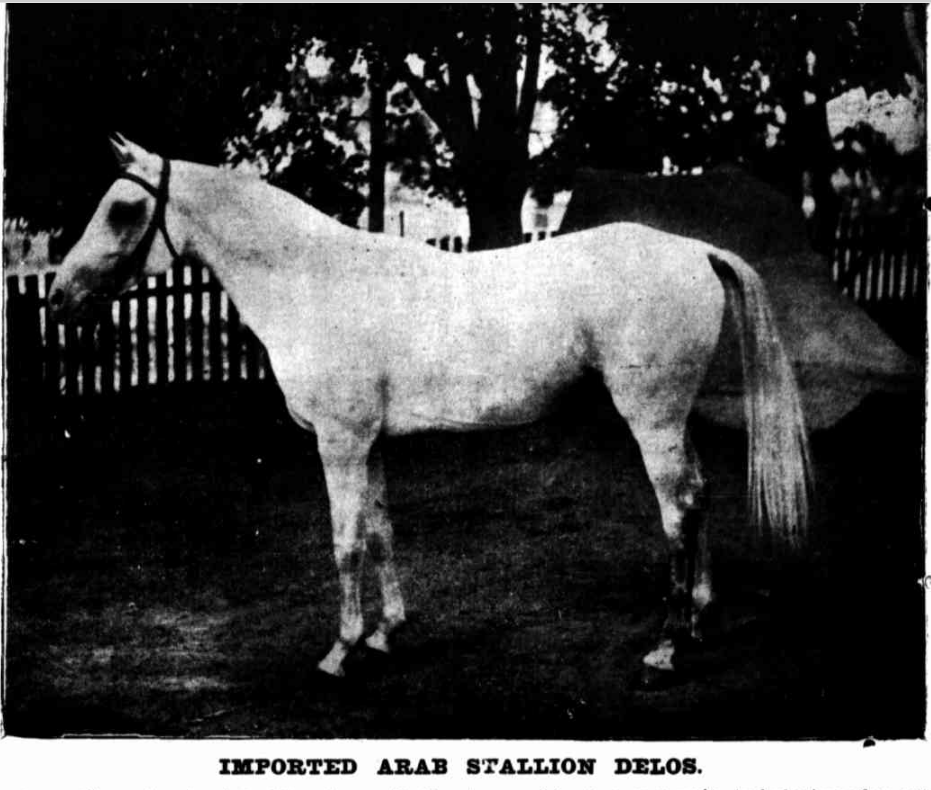
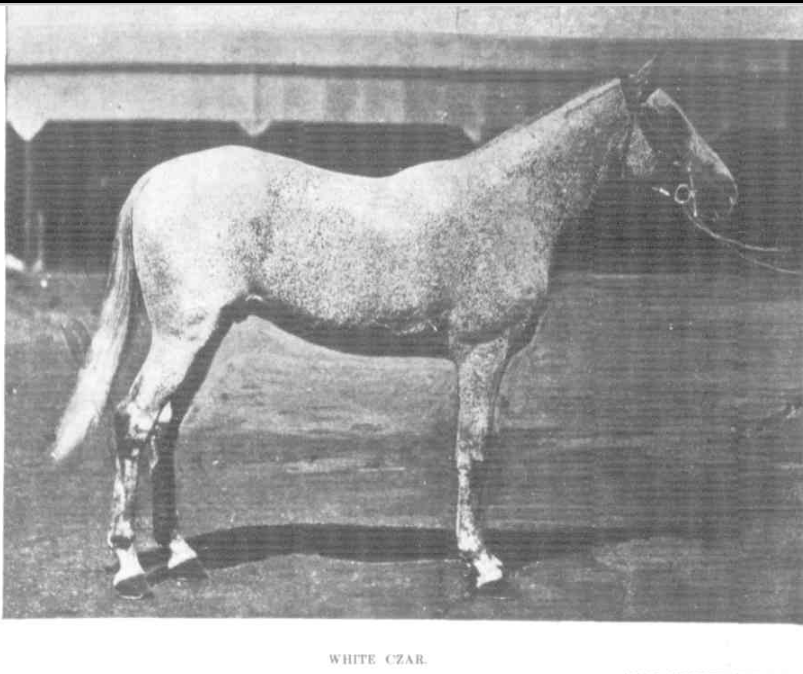
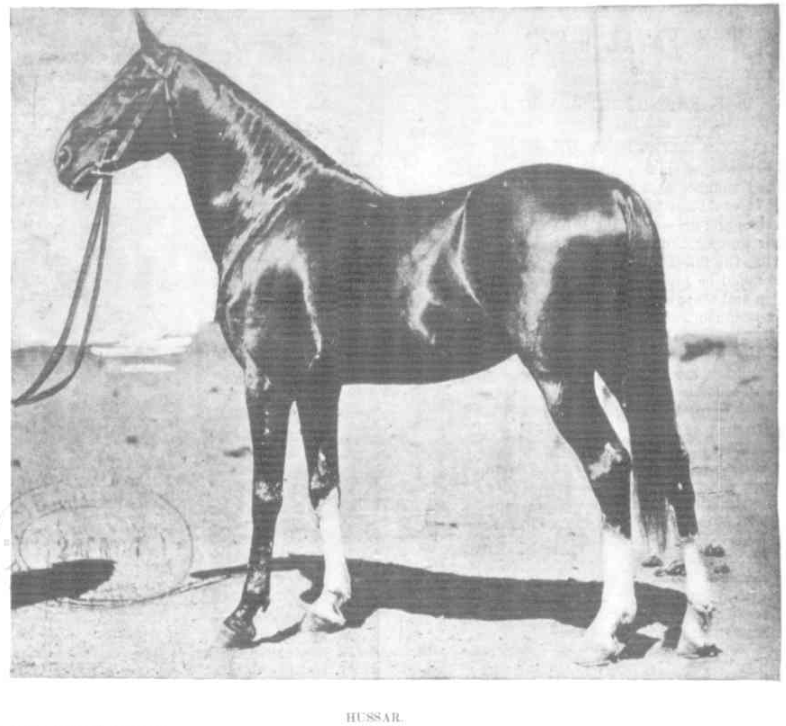
Two Arab stallions bought in India by T.J. Burke for Sir Rupert Clarke, for breeding India horses
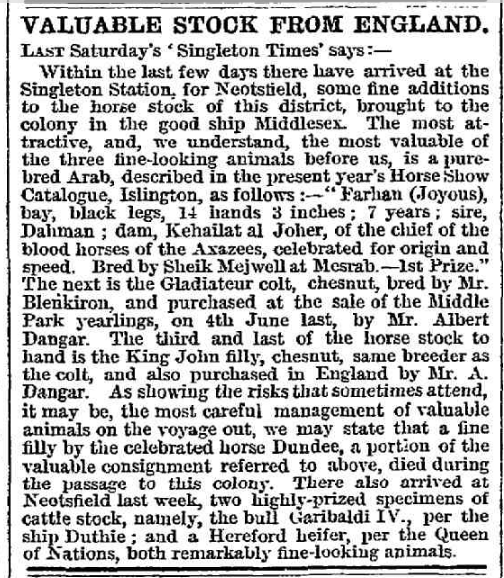
A.A. Dangar raced his Arab horses from England – hoping they would outshine Thoroughbreds – however they were woefully slow, unlike the Arabs from India. He eventually gave up the idea, and went on with Suffolk Punch breeding instead. He did sell some crosses of his Arabs to India however, and recouped his money.
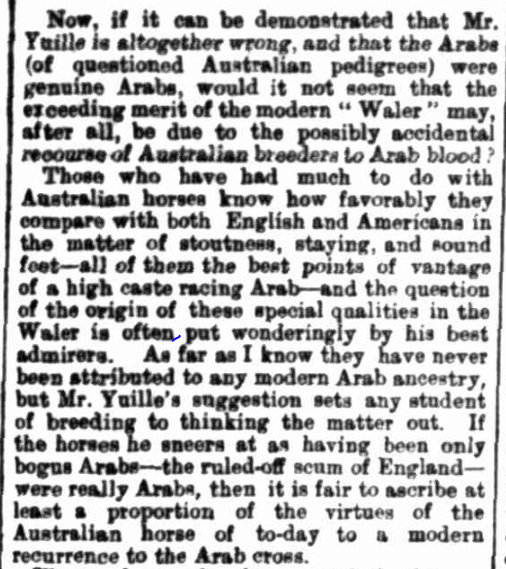
Sportsman, Melbourne, Wednesday 1 April 1891
Yuille was a founder of the ASB and maintained most Arab horses from India, were British horses sent there after various racing scandals, however, this would have only been a fraction of them; he was biased against all but English Thoroughbreds.
Arab horses came here early – certainly from 1803. Even once we began exporting horses there, the horse ships always brought one, two, or more Arab stallions back – sure of a profitable sale. Their offspring, crosses, went back to India for sale to armies and Maharajahs. Many Arabs got into the Thoroughbred stud book here (ASB).
These little Arab horses, many ponies, were incredibly tough – popularly raced in India, over long distances. Those that came here were usually famous winners – some having won over 100 races.
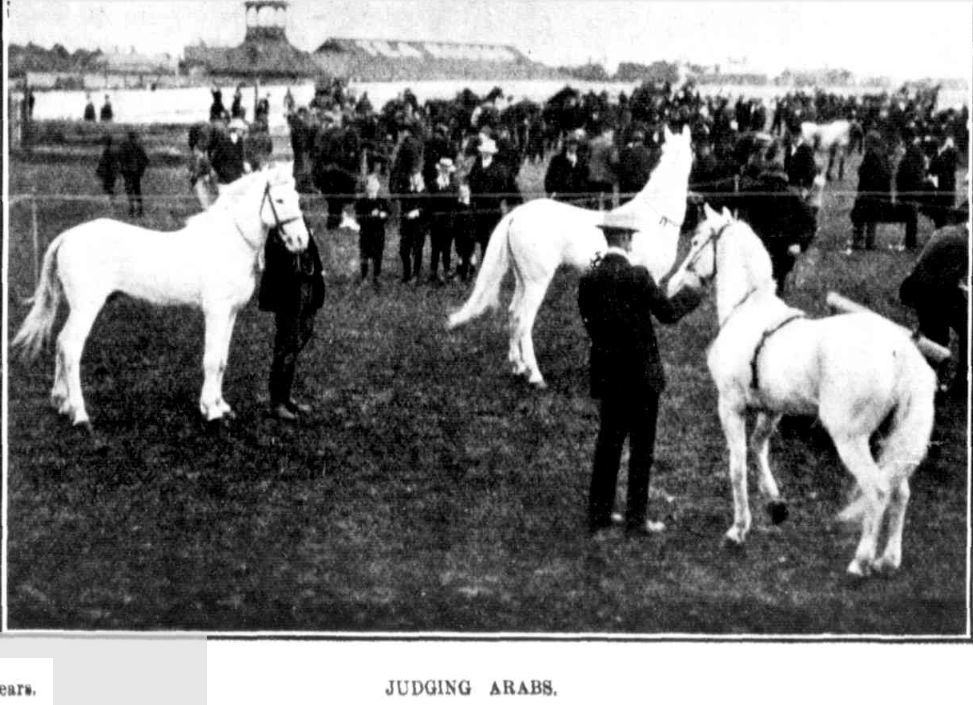
They were very good natured and had good bone, many measuring 8 inches and bigger; usually straight nosed, not dished, big eye, big nostrils, good length of nose, high set tail, arched neck, clean legs, short croup often flat; well sprung barrel; few had the 17 ribs then, most had 18 like other horses. Over time many lines have changed, like many breeds. We imported a few from the UK too.
A favourite of Frank Hurley’s was Abdul, he wrote about riding Abdul in his diary on 12 January 1918, “Abdul has become a great friend and is a capture from the Turks at Beersheba. He is one of the most beautiful little creatures I have ever set eyes on: a perfect model of Arab breed and blood.” Esdud, Palestine, 11th January 1915.’
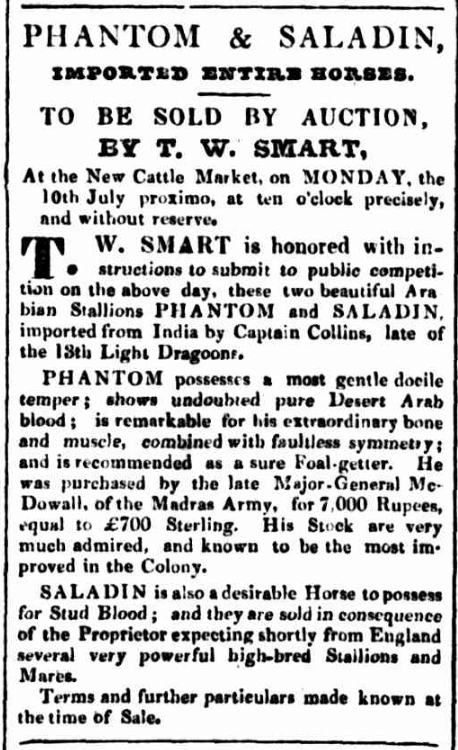
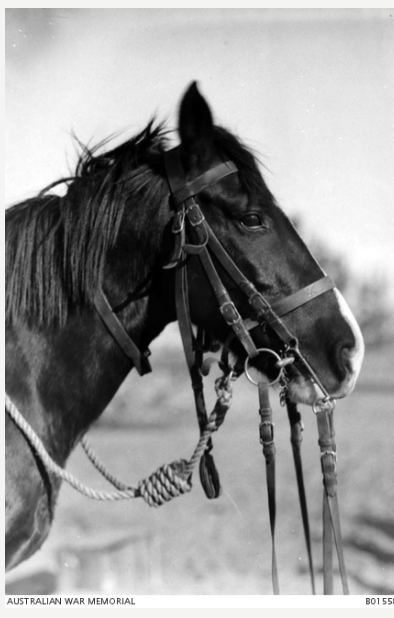
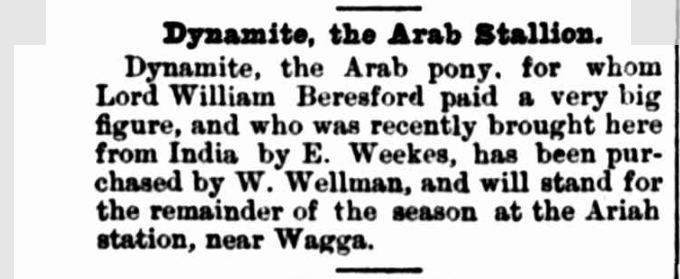
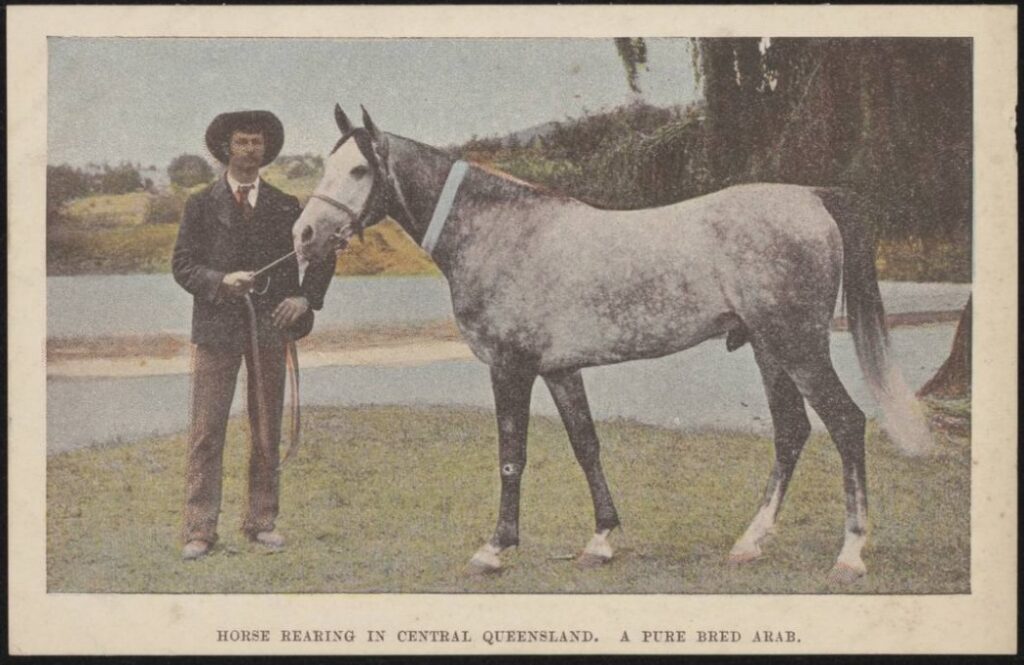
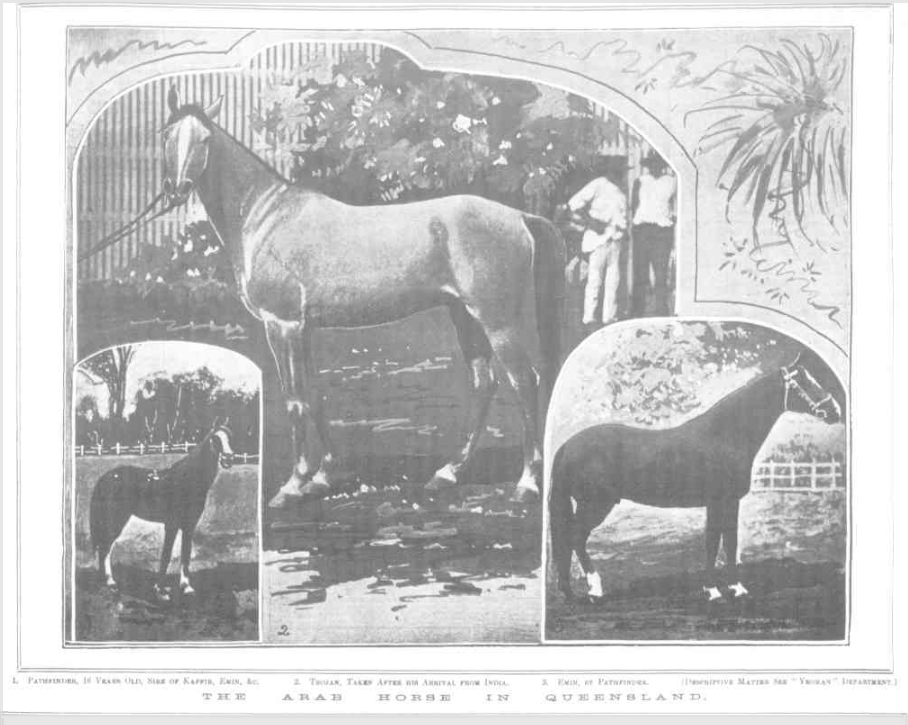

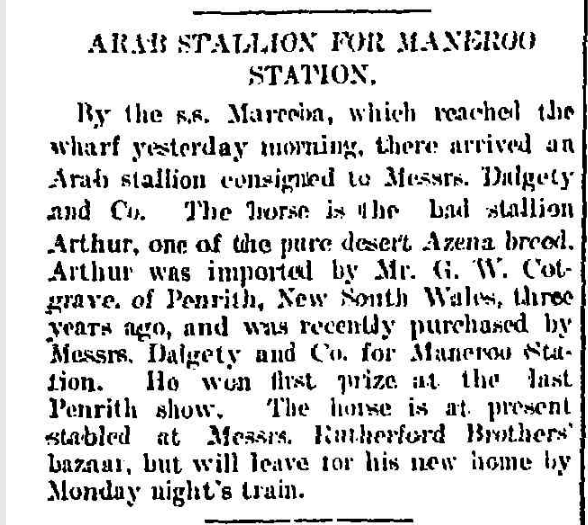
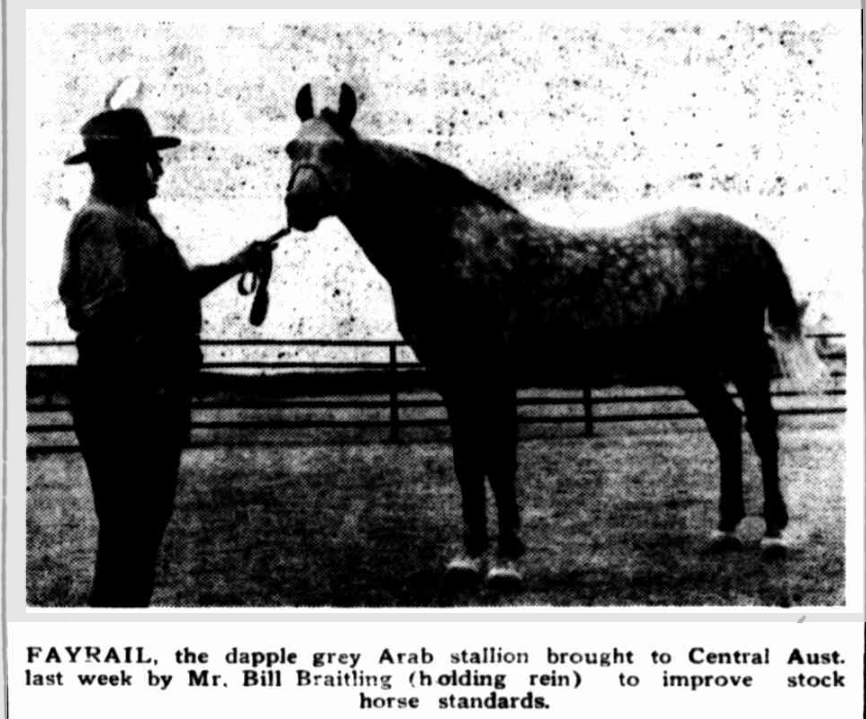
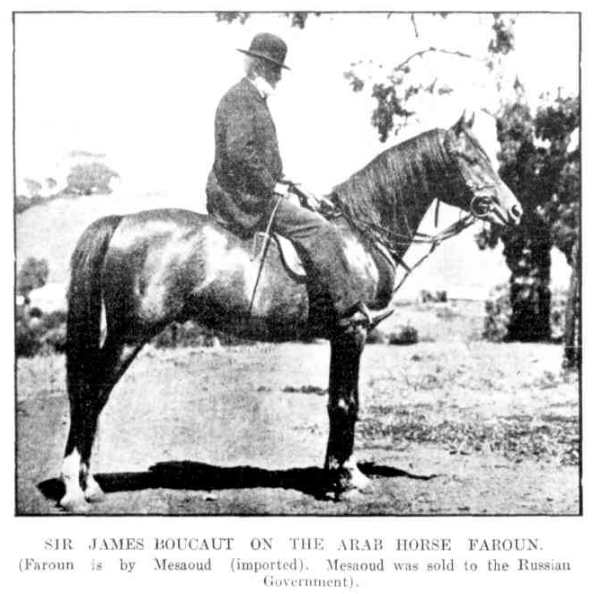
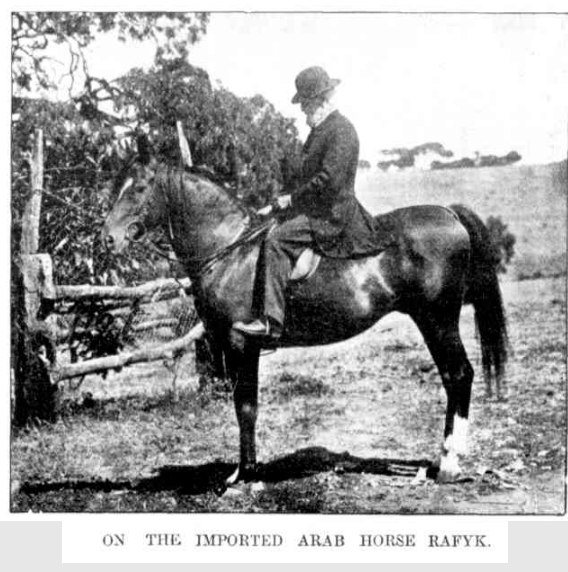
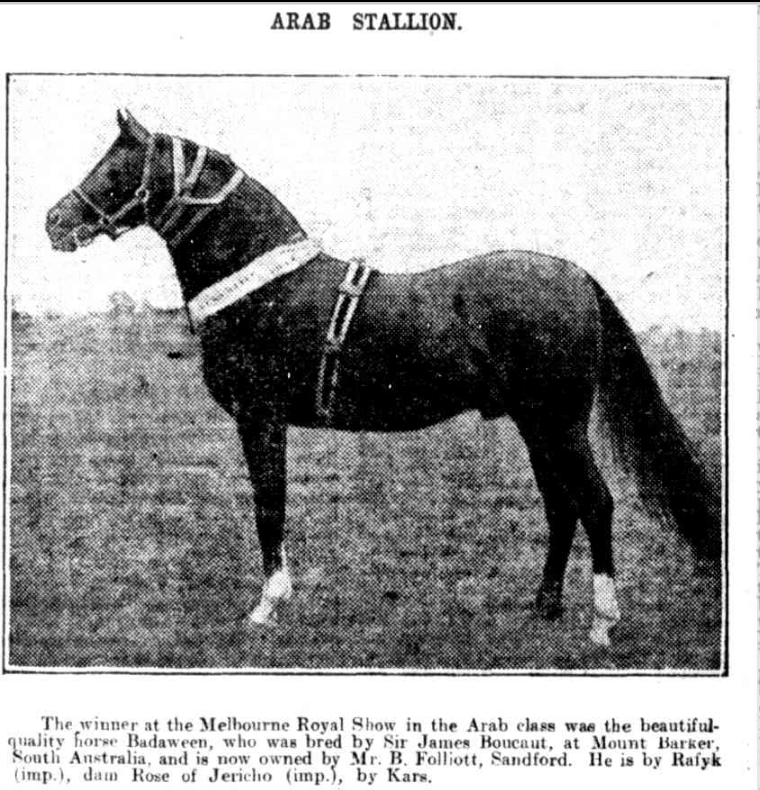
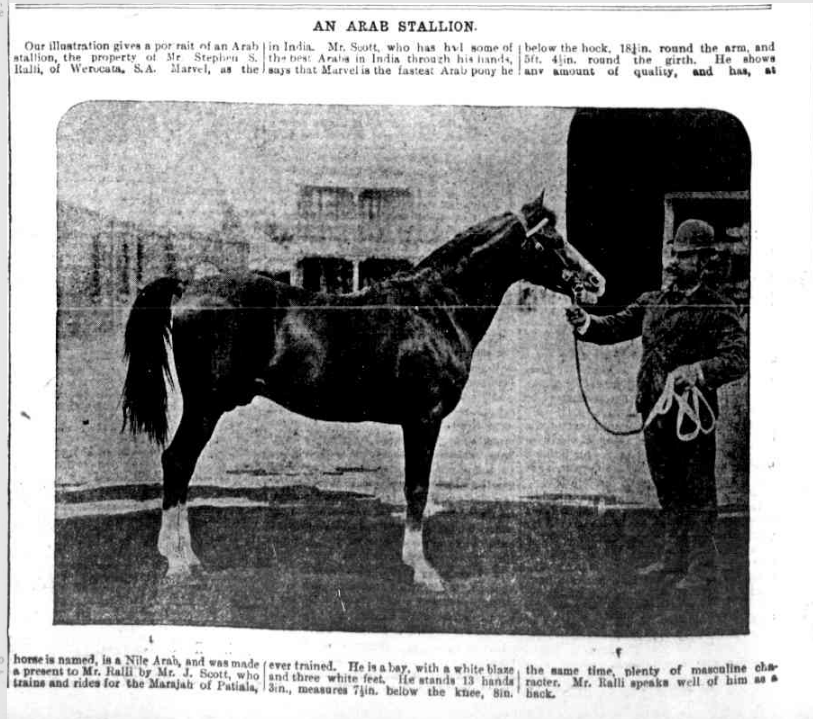
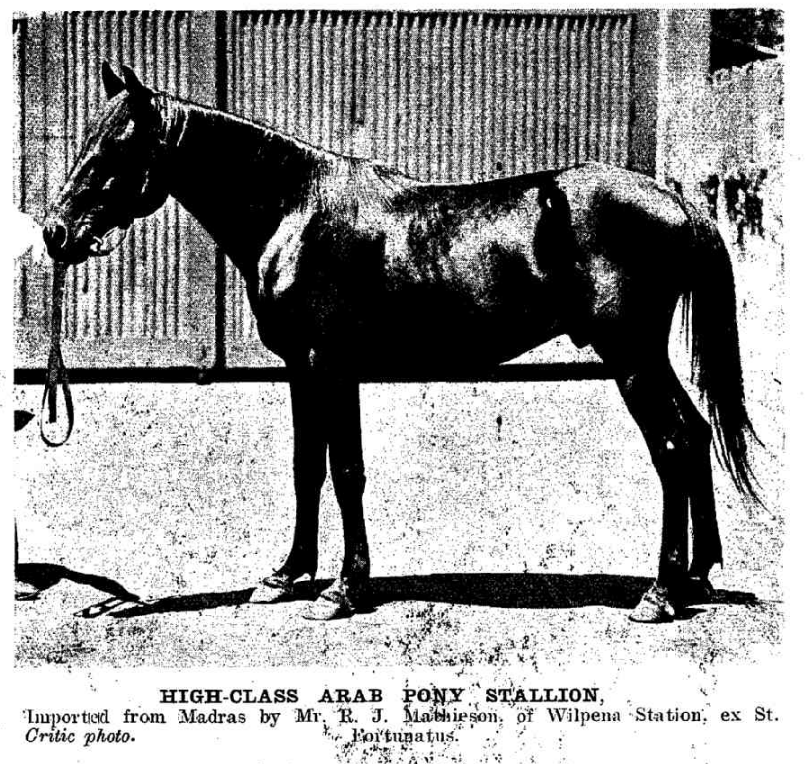
Images: Centralian Advocate, Friday 18 December 1953. Fayrial went along the Tanami, and eventually lived on Newhaven station (note article spelled his name wrongly – it’s Fayrial). Chronicle, Adelaide, Saturday 20 February 1904 (Faroun and Rafyk, Lady Wentworth’s Crabbet lines).
The Australasian, 14 October 1916; The Australasian, 2nd May 1896; Critic, Adelaide, 13 January 1904.
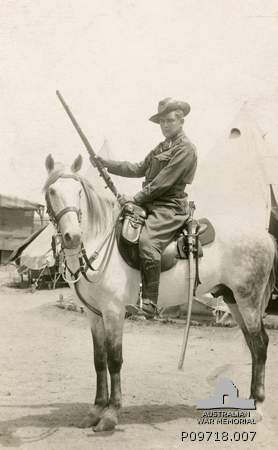
‘Outdoor portrait of 1102 Private (Pte) Clarence Albury Hickman, 1st Australian Remount Unit, from Collins Vale, Tasmania mounted on a horse. A 21 year old orchardist prior to enlisting on 30 September 1915, he embarked for overseas with Squadron 4 from Melbourne on 12 November 1915 aboard HMAT Orsova (A67). On arrival in Egypt, he was admitted to hospital for the first of many periods of hospitalisation while serving in the Middle East. He was treated in hospitals in Abbassia, Montazah, Rafa, Moascar, and Jericho. Pte Hickman arrived back in Australia on 29 August 1919. The handwritten note on the reverse of the image reads “Dear Mother and Father. I had this taken the other day the horse belongs to a friend of mine an Arab mounted policeman. The horse is an Arab stallion a real bonza. I thought I’d learn Arabic and tell you after I’d learnt but as you mentioned it I might as well tell you now. I can talk now about as good as Carl could talk English when he asked dad for a job. I’ve got a couple of pals (Arab policemen) and I go up and have a yarn to them and they can’t speak a word of English.” This is one of a series of 17 images relating to the service of Private Clarence Albury Hickman. Egypt.’
Australian War Memorial